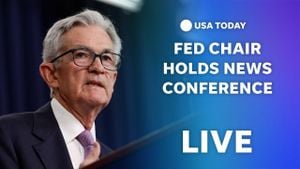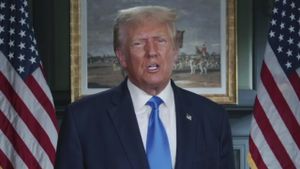Tragedy struck the Kurram district of Pakistan’s Khyber Pakhtunkhwa province on November 21, 2024, as sectarian violence reached new heights following a devastating ambush on a Shia Muslim convoy. At least 42 people lost their lives, with over 30 others injured when gunmen targeted three vehicles carrying Shia travelers from Parachinar to Peshawar. The attack sent shockwaves throughout the region, intensifying longstanding tensions between Sunni and Shia communities.
The assailants launched their ambush near Parachinar, hitting the convoy with relentless gunfire, which left many passengers helpless amid the chaos. Eyewitness accounts noted the attack's brutality as victims were forced to flee for their lives. Grief quickly turned to anger as local residents gathered to express their outrage over what they deemed the government’s failure to protect its citizens from repeated attacks.
This incident was not isolated but rather the latest flashpoint in Kurram, where sectarian strife has simmered for decades. The Kurram district, which borders Afghanistan, has become notorious for violent clashes between Sunni and Shia communities, with previous attacks killing hundreds. For many locals, the conflict stems from policies implemented during the regime of former dictator Zia-ul-Haq, which fueled religious intolerance and divided communities.
Following the tragic convoy attack, demonstrations erupted across multiple regions, including Gilgit-Baltistan, where thousands took to the streets to condemn the government’s negligence. Protesters criticized local authorities for their inability to safeguard the Shia population and demanded decisive action against militant groups. Their fervent calls echoed the frustrations of many Shia Muslims who feel increasingly vulnerable to extremist violence.
This attack marks the sixth major assault on the Shia community within just one month, highlighting the pervasive nature of sectarian violence. According to local leaders, the incident occurred even with security personnel reportedly stationed nearby, prompting accusations of gross negligence and potential complicity within the state apparatus itself.
The outcry against this latest assault has also included condemnation from political leaders across Pakistan. Prime Minister Shahbaz Sharif and Chief Minister Ali Amin Khan Gandapur extended their sympathies and promised investigations, though many residents remain skeptical. They view official statements as hollow amid the palpable grief and anger gripping their communities.
Local activists, like Mohsin Dawar from the National Democratic Movement, have underscored the necessity of addressing the unique historical and social dynamics of Kurram. Dawar pointed out the harmful effects of proxy wars instigated by external influences, cautioning against the potential for these conflicts to escalate as foreign powers continue to manipulate local divisions for their strategic ends.
Reports from Kurram suggest the tragic events have drawn mixed responses from the government, which has attempted to attribute the violence to land disputes among tribal groups. Critics vehemently reject this narrative, asserting such disputes have never resulted in violence on the scale witnessed. The general sentiment among residents is one of deep frustration, feeling abandoned by authorities who promised to provide security but repeatedly fell short.
Waves of violence have devastated the Shia community, which comprises roughly 15% of Pakistan’s population. Recent news shows hundreds have perished due to sectarian-based violence, with many fearing the situation will only worsen. Locals have voiced their demand for the government to take meaningful action against the Tehreek-e-Taliban Pakistan (TTP) and other extremist groups known to exploit sectarian cleavages.
The outrage following the convoy attack reached international courts as UN Secretary-General Antonio Guterres condemned the assaults on civilians, calling for accountability for the perpetrators. He voiced his hopes for thorough investigations but with skepticism from many sides about whether this would translate to any real change.
Culmination of this crisis forms part of the larger narrative of sectarian violence plaguing not only Kurram but Pakistan as a whole. With educational institutions closed and fear governing daily life, residents find themselves locked in cycles of violence and retaliation. Protesters have demanded the government reshape its security policies significantly and prioritize the Shia community’s protection.
Returning to the streets, demonstrators have taken up the mantle of activism, calling attention to their plight and raising awareness about sectarian issues, hoping their voices will finally penetrate the walls of governmental indifference. Their determination to seek justice and safety continues to galvanize both local and international support.
The challenge moving forward rests on whether authorities can effectively address the roots of these conflicts, which run far beyond the surface-level accusations of tribal disputes. Engaging with local communities and rectifying longstanding grievances might offer the only means to find some semblance of peace. Nonetheless, with tensions continuing to simmer, the hope remains dim for those affected by the recurring tragedy of sectarian violence.



